{Now and then, we get sent an article that simply deserves to be read by as many anglers as possible. The following piece on how to make your own shads is one such article! Thank you, Norman. I hope that a few people decide to give it a try after reading this.
I’ve kept the pictures as large as possible. It means that the layout may not be as ‘pretty’ as it could be, but I think it’s better to have clear instructions than a pretty page – Ed}
How To Make Your Own Shads
By Norman White
First, a few words of warning… I will try to cover as much as possible, however, in doing so, it may be a long and tedious read as the subject matter is so vast. Continue at your will and I will try not to bore. Secondly, if you do try it yourself, be very aware that failure comes in multiples at every step before eventual success……. don’t be put off by this – just “do it again” (and again)!
I initially caught on to this project after a chance meeting with Chris, another boat owner in Royal Quays Marina on the Tyne, who showed me his winter work in making silicon flatty type lures …. a sudden light came on in my mind and I was literally hooked.
The past few years have seen many of us latching on to fishing with Shad type lures and I know from my own experience that to feel confident on a trip out in the summer months, you need to have every pattern, size and colour of shad to hand. There’s always one type on the day that seems to catch more than anything else ….. then, it’s a different one the following trip! so a selection is mandatory.
Enough said about the merits of shad lures, that’s an essay all in it’s own right …….. back to making them.
The Aim ….. (these are actual results) is to produce professional looking 3D Shads and Lures complete with Pre-Weighted Hooks.
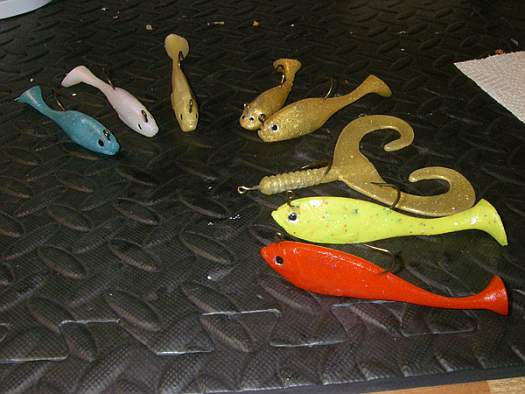
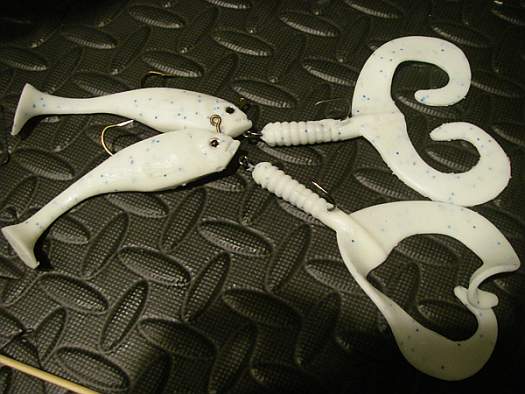
The Method
Although there is a potential cost saving, I would think it will be several years before I could ever realise this, as the initial set-up cost, bearing in mind the number of failed and modified parts and moulds, will easily wipe away the cost benefits. This is most definitely an experience finding project, not a cost cutter.
The one thing that cannot be priced, though, is the pleasure that success of a good moulded shad brings, and hopefully the pleasure, also, of a good fish well seduced and well hooked!
The secret is in the mould; there are several levels you can attempt, from basic flat one sided pour into worm moulds made from plaster of Paris, all the way to double sided moulded hooks and weighted 3D types from silicon type material. The latter was my final aim and that is what this article is aimed at, although I did go through the flat pour first, as there were no instructions to be found, just a very steep learning curve which I needed to go through to achieve my final aims (well, when I get to my final aims that is!).
Okay, there are 3 basic steps to take, as follows:-
- A master model must be made (or this can be an already existing shad if you simply want to copy it).
- A double-sided mould must be cast from this master, which will then become the production mould, similar to the moulds used in making your own weights. However, those are usually purchased, rather than made.
- Using this mould, many shads can be cast (again, similar to casting your own lead weights).
One by one, the 3 steps in more detail……
The target is to have a mould (step 2) that will mould a shad. If there were any commercially available, then they could be purchased. However, they are few and far between and not to my liking. If I had had sole access to a CNC milling machine, then I would, maybe, think of machining the two mould halves. However, my garage supports simply a small mini-mill and mini-lathe, so I have had to produce the mould by other means, as follows…
Step 1. The Master Model
This is simply a form representation of what you want to finish with, in shape and size. It can be made of any material, as it will be disposed of after casting the mould. My first attempts were with a master model of plastercine. However, this was not as stable a material as I would have liked and led me to search for something better.
I have taken to carving from balsa wood; this allows you to totally design your own shape and size and be as creative as you wish.
When creating step 2 (the shad mould), this model must be held supported, to allow the mould material to flow all around it. Therefore, using a standard shad to copy from is difficult at this stage as it is flexible and is unable to be easily held in place while casting, whereas, if you are using a wooden master, then it’ rigidity allows it to be held easily in the mould.
No secrets here; just a few bits of balsa wood superglued together, then whittled away with a knife. TAKE CARE – have some sticking plasters at the ready! This is one of the steps that you may have to re-start a few times until you get just what you want.
Points to watch at this stage:-
The split line of the mould will be all around the top and bottom edges, as can be seen in later pictures, so avoid any areas that may cause undercutting and so prevent release of shad from the mould. Like, for instance…
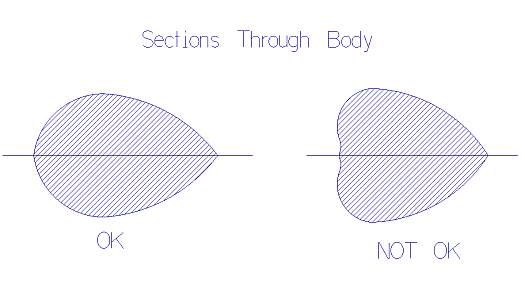
With a silicon mould, there is a bit leeway due to the flexibility of both the mould and the shad material, so they will still probably release in the condition show above. However, avoid overhangs if you can.
Make the eye sockets as drilled holes into the shad model and not protruding. This allows standard “fish eyes” to be glued in easily, giving a life like appearance. I use a 5mm milling cutter in a bench drill and go about 1mm deep.
Make the tail boom thinner than its height (ie oval); this induces a side to side swim waggle, rather than a round and round waggle.
Finish by sanding to as smooth a surface as possible, then either varnish to seal the wood or, as I do, spray with a grey primer paint (from any car accessory shop) and polish further with fine wet and dry. Several coats may be needed here to accomplish a good surface finish.
As can be seen from the pictures, I use a pin in the tail to hold while spraying.
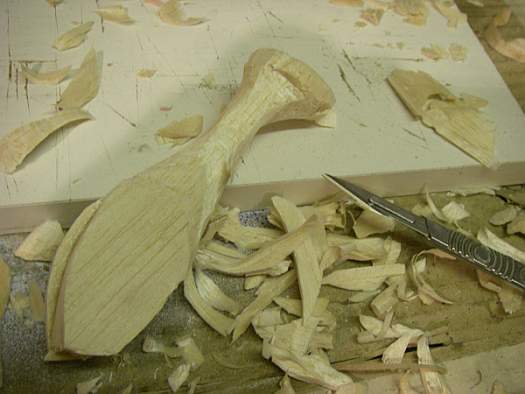
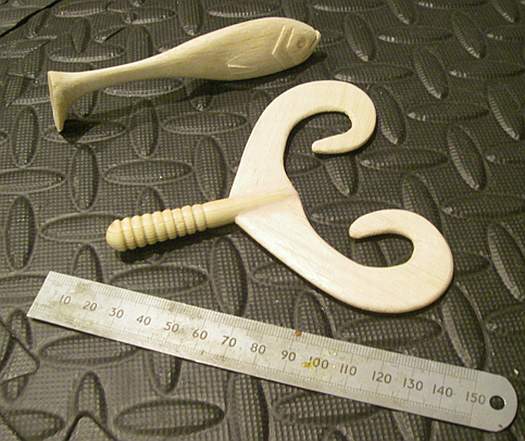
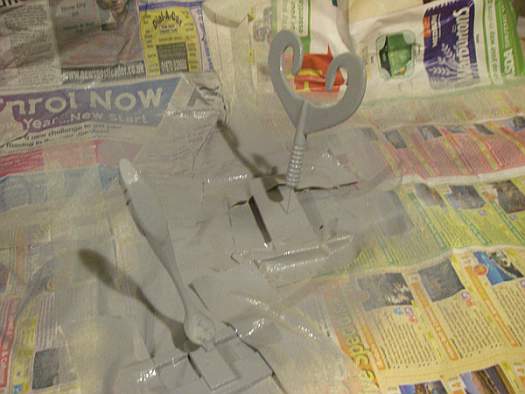
Step 2. The Mould
The mould can be made in several ways, as with everything in this guide. The following is simply the method I have developed.
The mould is made in two parts, split along the centre line of shad in a top to bottom direction. I have added, through development, a couple of extra steps;
a) I have added a backing of fibre glass resin to both sides of the mould. This was due to the originals taking up a lot of the silicone RTV material and, also, as an aid in the stiffness of the mould itself.
b) I have added location posts to ensure each half lines up and, also, 4 off clamp posts. These are four pieces of dowel that are moulded into each half (in the resin and the silicone) and touch each other when the mould is closed. This prevents over squashing of the mould prior to injecting. Without these, I found that when loosened from vice, the mould would expand and cause holes in the shad at the pour point.
c) I have added a spru, or pour point, as a piece of dowel. In earlier versions, I just cut this pour slot with a knife, but a dowel leaves a lot neater hole allowing better injection of plastic.
d) I have added a hook support in an attempt to guide the hook and the weight to sit in the centre of the mould.
To make the mould is fairly time consuming, but worth every minute. Firstly, measure up your master and make a box big enough to take half of its depth with at least 8mm extra in depth. I have been using boxes made of 6mm balsa that had internal dimensions of 150mm x 50mm x 18mm deep. This equates to the shad sitting comfortably in the middle, with height for the full hook and at least 6mm clear all around any other part (this will alter, depending on the size of your own master model).
Next fit a cover of 6mm balsa over the bottom and fully seal all internal edges with a thick layer of superglue (this is to prevent leakage of mould material). Add a support block in the area of the hook to be level with the top edge.
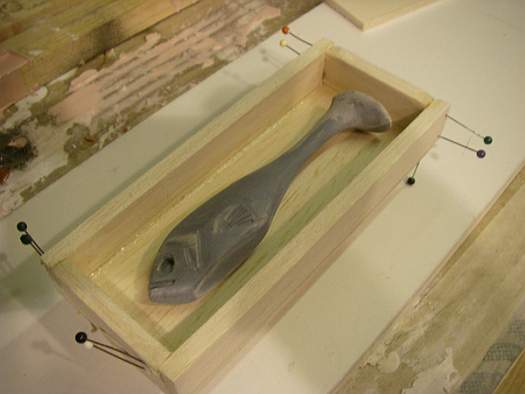
IMPORTANT – smear Vaseline as a release agent all over the shad model, trying not to leave lumps that will be replicated in the mould. Ensure the eye sockets are free from Vaseline build-up.
The model has to be supported in this box with the centreline (split line) of the model level with the top edge of the box. To do this, I use modelling pins from beneath and stuck into the shad model (a lot easier with a solid wooden model than a flexible shad model). I find I can usually get away with just 2 pins; one through the base into the eye socket of the shad and the other into the tail, manipulating them to cause the shad to lie level.
Note: These pins have to be removed when the first half mould is cast otherwise they would remain in your cast shad. However, since I wish to first pour a layer of resin in the bottom of the box this would prevent easy removal of the pins. To get over this, and to act as a guide to thickness of resin, I first glue two blocks of 6mm balsa in the areas the pins are to be placed, thus preventing the resin reaching the pins.
Next add and glue to the base the 2 off locating posts (6mm longer than the box depth) and the four clamp posts (the same length as the box depth). The positions of these are not important, simply to be spaced fairly evenly.
Lastly, add the dowel that is to become the pour hole into the position at the base of the shad.
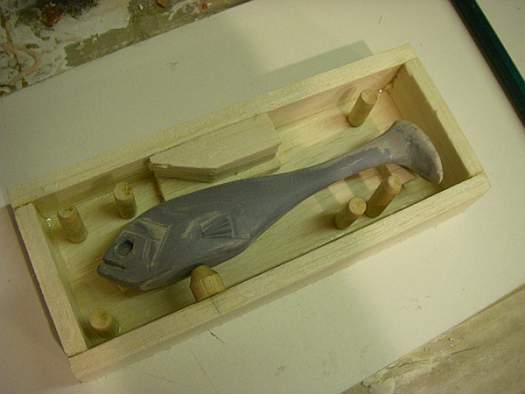
With all this glued and the shad sitting in place and the centreline level with the top of the box, mix some glass fibre resin and hardener (again from any car accessory shop), about as much would half fill the average cap of a spray tin, and gently, where space allows and without touching anything, pour into the box until level with, but not above, the 6mm blocks supporting the pins and leave to dry for at least a couple of hours. The box will have to be placed on support blocks, as the holding pins will protrude underneath.
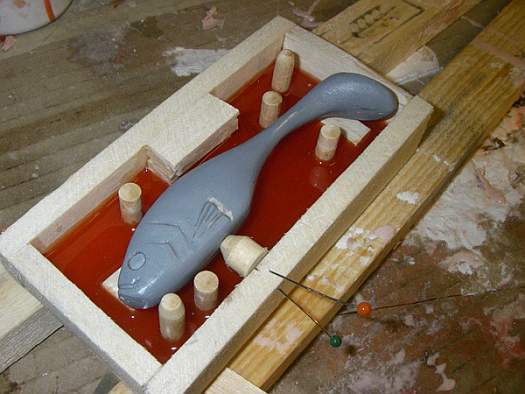
A keen eye will notice the previous two pics are each of a slightly different shad …. That shows how many I must have now attempted to get it (almost) right!
After again checking and adjusting the level of the master (which to this point is still just supported by the pins), mix some Silicone RTV material, probably about 2 or 3 times the amount of resin that has just been mixed, and VERY CAREFULLY dribble/pour into the mould box until it is level with the top edge which is also level with the split line. This material has a long working time, so no rush at this point. After half filling, try to roll the material around a little by tilting the box to ensure all features such as eye sockets are filled and to ensure no air bubbles exist. You may have to level the box up with slivers of paper to achieve a level top but, again, this is no problem as the working time is long. Leave to set for at least 24 hours. Check for cure; it should feel dry to the touch, with only a little allowable depression. Remove the underneath holding pins.
For this moulding material I use a product supplied by Lurefactors.
By this time, it’s sure to be looking good, especially if it’s your 4th or 5th attempt ………
And now it looks like this ……
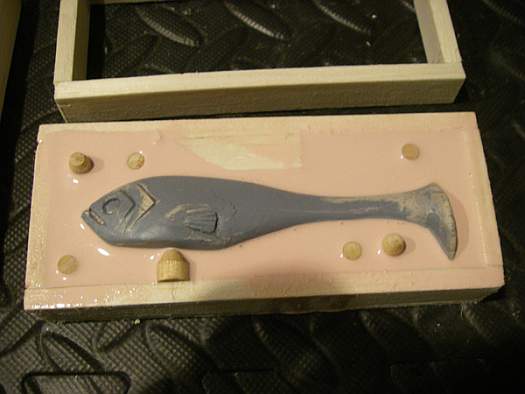
Next, make another identical box but do not fix the top onto it yet.
Smear more Vaseline over the protruding half of the shad model and also smear plenty on the surface of the silicone and lower box edges. Ensure everything from the initial bottom half is well coated in Vaseline (as a mould release agent), including the 2 protruding location pins.
Place the top half box in place over the bottom half and fix with masking tape all around (may be a good idea to add a few pins while fitting the masking tape). Ensure all is tight and there is no chance of leakage. Support the second set of 4 pins over the top of the four in the bottom half mould and hold in place with cross braces, then, once again mix some Silicone RTV and carefully pour into the top half of mould over the master model. Fill until mould material fully covers the master shad and until it is approx 6mm from the top edge of top half. Leave to set again for a minimum of 24 hours.
Prior to filling 2nd half with support pieces in place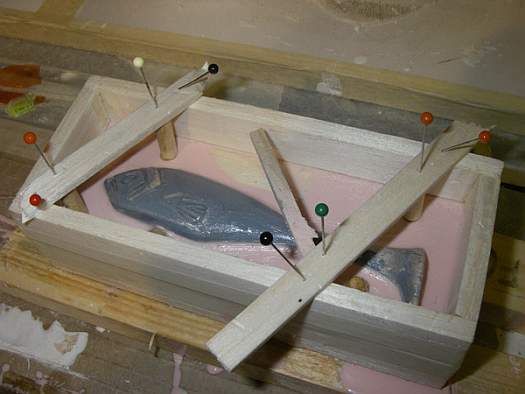
Second Half filled awaiting cure …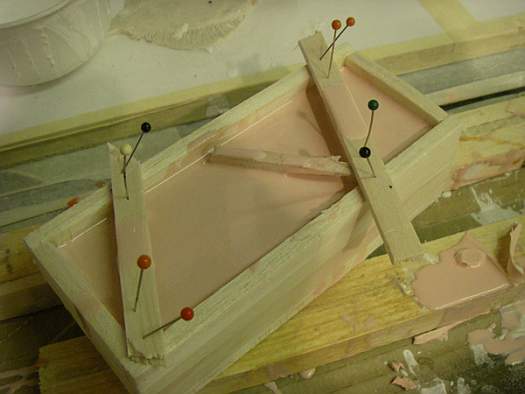
When cured, mix and fill to the top the final part of the top mould with glass resin. Add and glue in place over the top a 6mm balsa top sheet.
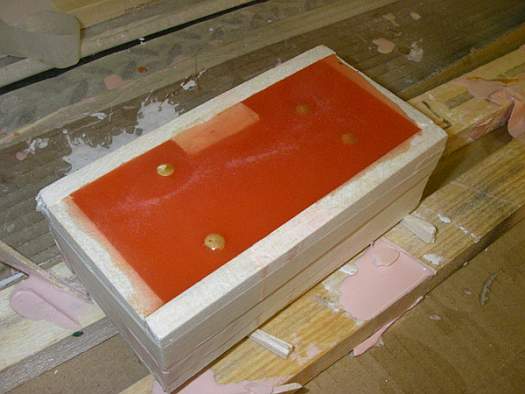
OK here it is… “The Reveal”! Remove the masking tape and gently pull the two halves apart. There may be the odd spot of silicone to cut with a scalpel, but hopefully it will come apart clean. Carefully remove the master model from whichever half it is held in. If it comes out clean, then make another mould with it, but if it breaks , no problem, it’s done its job and you’re finished with it, anyway.
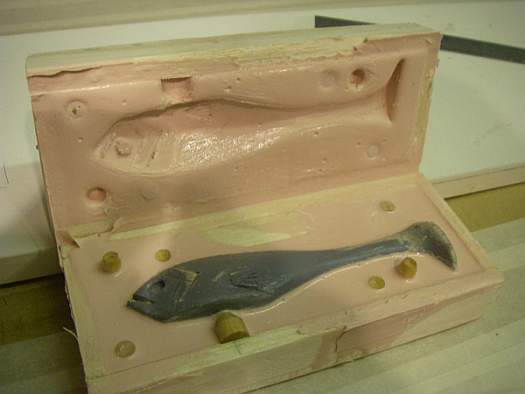
Remove the dowel creating the pour hole and cut through the balsa to open up pour hole fully. Next, cut a small vent slot straight up in one half only from the tail to the edge to ensure venting and full fill of tail. There may be another vent to cut at the head but this will only be determined by trial casting ………….
Finally, cut a small slot in the silicon for the eye of the hook (both halves) and cut a groove in the hook support to follow the hook bend.
That’s it – easy, eh?
Step 3. Casting a shad ……
I fit a 4/0 or 5/0 leadhead jig hook fitted with a home made lead weight – this is whole new series of instructions to make your own special leadhead mould if anyone would like 🙂
Firstly, prepare a number of weighted hooks ready for the casting (with a variety of shads, you may well need a number of different types of weighted hooks)
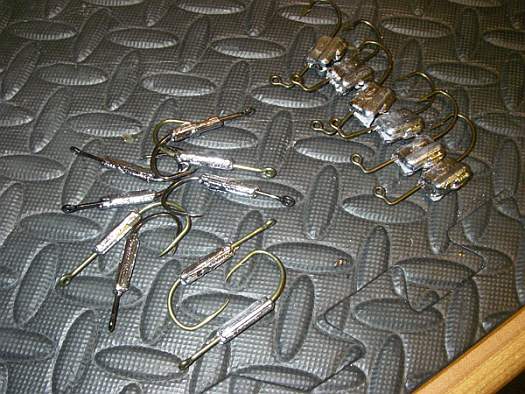
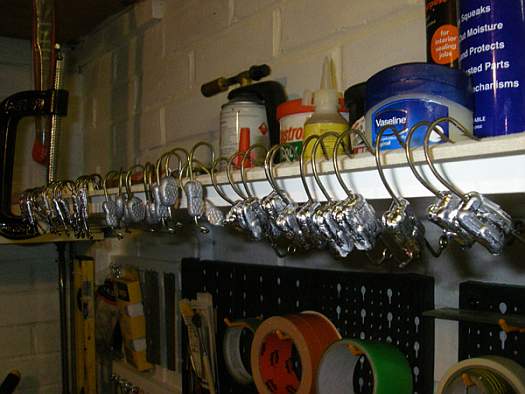
The material for actual Shad casting is a Liquid Plastic, again available from Lurefactors.
This is a PVC suspension which is like milk initially, then, after heating, becomes more viscous and clear. Then, after further heating, it becomes more liquid and almost pourable. In this condition, we need to inject it into the mould to ensure it fills, This is done by getting the material into as liquid a state as possible, then drawing it into a plastic 50ml syringe and, finally, injecting it into the pour hole of the mould. Try not to touch the base of the pan with the top of the syringe, as the melting point of the plastic and syringe are close, hence you lose the tip easily!
Not a lot more to say about this stage just
a)be careful as it’s hot!
b) I use a pan and as little heat as possible, as it burns easily (although I think a move to a microwave is imminent).
c) inject one mould at a time, then empty the balance of material back into the melting pot.
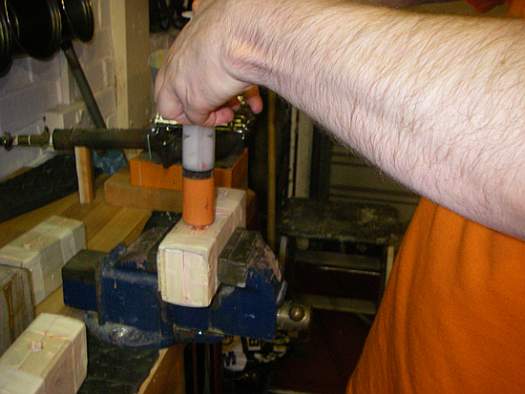
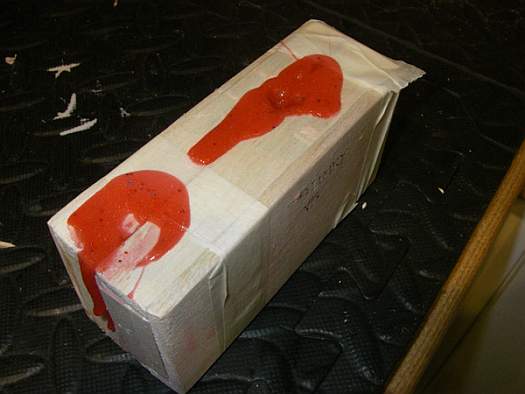
It takes about 5 minutes to set hard enough to remove from mould and any flash can be removed and re-melted as you go. There are a variety of colourings available, as well as the fact you can mix colours to achieve your own designs. There’s also a variety of glitter to add sparkle.
The actual making of the shad, although it has a similar steep learning curve, is not so bad once you get in the swing of it, but key to all of this is “the making of the mould”. If it’s a good one, then everything that follows is so much easier, but if it’s not good, like bad filling or leaking or the hook does not hold in place, then it’s all up hill. Time to try another one ….
Although this guide is rather long it still barely scratches the surface of the possibilities and of the failures along the way . My latest creation is a twintail mould that is similar in approach but with the hook rotated at 90 degrees …. another problem to overcome!
But it is possible …….. here’s one of the first twintail castings
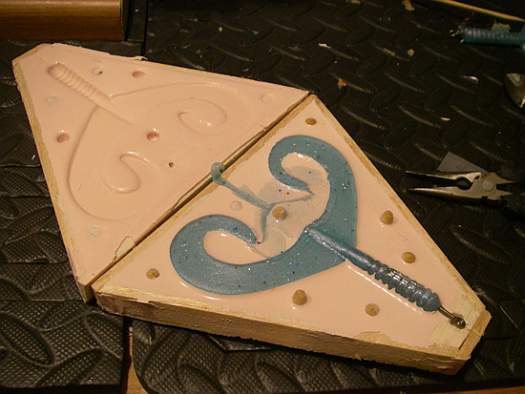
A big thanks at this point to my friend and Crewman, Tony Gray, for his endless help in creating what we now call the Slinky Kate Shads ………….

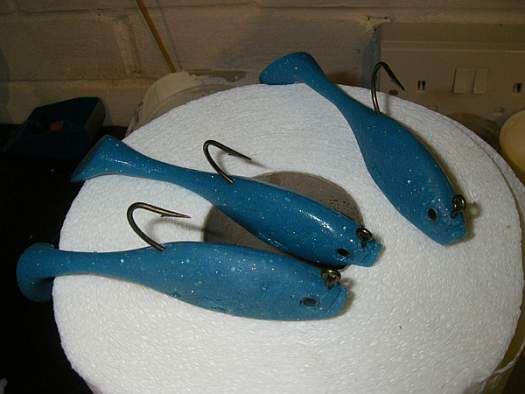
I hope this “how to” has been of some benefit. It’s all there awaiting the inventive…
As previously mentioned, this guide is “My Way” – I’m sure there are many other methods awaiting……..
Good Luck and tight lines,
Norman White – Feb 2013